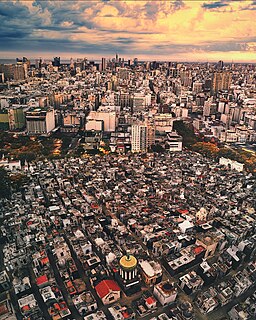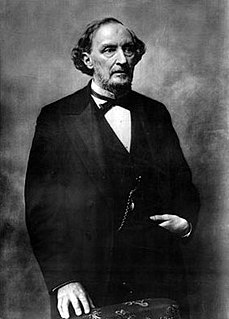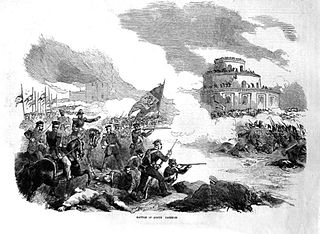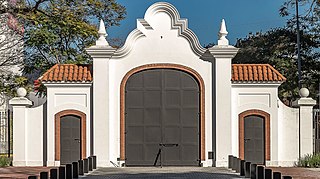
Carlos Saúl Menem is an Argentine politician who was President of Argentina from 8 July 1989 to 10 December 1999. He has been a Senator for La Rioja Province since 10 December 2005. Ideologically, he identified as a Peronist and economically liberal, serving as President of the Justicialist Party from 1990 to 2001, with his political approach called Menemism.

La Recoleta Cemetery is a cemetery located in the Recoleta neighbourhood of Buenos Aires, Argentina. It contains the graves of notable people, including Eva Perón, presidents of Argentina, Nobel Prize winners, the founder of the Argentine Navy, and a granddaughter of Napoleon. In 2011, the BBC hailed it as one of the world's best cemeteries, and in 2013, CNN listed it among the 10 most beautiful cemeteries in the world.

Eduardo Alberto Duhalde is an Argentine politician who was President of Argentina.

The Argentine Confederation was the last predecessor state of modern Argentina; its name is still one of the official names of the country according to the Argentine Constitution, Article 35. It was the name of the country from 1831 to 1852, when the provinces were organized as a confederation without a head of state. The governor of Buenos Aires Province managed foreign relations during this time. Under his rule, the Argentine Confederation resisted attacks by Brazil, Bolivia, Uruguay, France and the UK, as well as other Argentine factions during the Argentine Civil Wars.

Raúl Ricardo Alfonsín Foulkes was an Argentine lawyer and statesman who served as President of Argentina from 10 December 1983 to 8 July 1989. He was the first democratically elected president after more than seven years of military dictatorship, and is considered the "father of modern democracy in Argentina". Ideologically, he identified as a Radical and a social democrat, serving as the leader of the Radical Civic Union from 1983 to 1991, 1993 to 1995, 1999 to 2001, with his political approach being known as Alfonsínism.

Juan Bautista Alberdi was an Argentine political theorist and diplomat. Although he lived most of his life in exile in Montevideo, Uruguay and in Chile, he influenced the content of the Constitution of Argentina of 1853.

Bartolomé Mitre Martínez was an Argentine statesman, soldier and author. He was President of Argentina from 1862 to 1868.

The Battle of Caseros was fought near the town of El Palomar, Buenos Aires Province, Argentina, on 3 February 1852, between the Army of Buenos Aires commanded by Juan Manuel de Rosas and the Grand Army led by Justo José de Urquiza. The forces of Urquiza, caudillo and governor of Entre Ríos, defeated Rosas, who fled to the United Kingdom. This defeat marked a sharp division in the history of Argentina. As provisional Director of the Argentine Confederation, Urquiza sponsored the creation of the Constitution in 1853, and became the first constitutional President of Argentina in 1854.

Carlos Tejedor was an Argentine jurist and politician, Governor of Buenos Aires Province between 1878 and 1880. Tejedor was a prominent figure in the movement against the Federalization of Buenos Aires.
Argentina is a country on the south coast of south America. The history of Argentina can be divided into four main parts: the pre-Columbian time or early history, the colonial period (1530–1810), the period of nation-building (1810-1880), and the history of modern Argentina.

The Quinta de Olivos is an architectural landmark in the north side Buenos Aires suburb of Olivos and the official residence of the President of Argentina. It is one of the President's official residences.

The Argentine Civil Wars were a series of civil wars that took place in Argentina from 1814 to 1880. These conflicts were separate from the Argentine War of Independence (1810–1820), though they first arose during this period.

The National Sovereignty Day is a national public holiday of Argentina, celebrated during November 20. It commemorates the Battle of Vuelta de Obligado, when a small Argentine army stood against an Anglo-French navy that broke into the Paraná River on November 20, 1845, against the will of the Argentine Confederation. Although the battle itself ended with an Argentine defeat, the losses of Britain and France in the whole military campaign were so high that both countries were forced to the bargaining table and signed a treaty with Juan Manuel de Rosas. The day was enacted as a national observance in 1974, following a request from the revisionist historian José María Rosa, and promoted into a national holiday in 2010.

Ángel Vicente "Chacho" Peñaloza was a military officer and provincial leader prominent in both the history of La Rioja Province and the Argentine Civil Wars that preceded national unity.

Ángel Pacheco, was an Argentine military officer trained by José de San Martín who later became one of the top commanders in the Confederacy during the dictatorship of Juan Manuel de Rosas. He never lost a battle under his command.

The historiography of Juan Manuel de Rosas is highly controversial. Most Argentine historians take an approach either for or against him, a dispute that influenced much of the whole historiography of Argentina.

Argentine nationalism refers to the nationalism of Argentine people and Argentine culture. It surged during the War of Independence and the Civil Wars, and strengthened during the 1880s.

Raúl Alfonsín was the president of Argentina from 1983 to 1989. He died on March 31, 2009, aged 82. He had lung cancer and died at his home; a massive candlelight vigil took place in the vicinity of it. Vice President Julio Cobos, the acting president at the time, arranged three days of national mourning and a state funeral at the Palace of the Argentine National Congress. Alfonsín was seen by 40,000 people and the senior politicians of the country; people from other countries also voiced their respect for him. A military escort took his coffin to the La Recoleta Cemetery, and left him at the pantheon for the veterans of the Revolution of the Park.

Alejandro Danel (1791–1865) was a French soldier, who served in the Napoleonic Armies, and in Argentina where he took part in the War of Independence and Civil War.



















